A quick scroll through fitness social media, and a brief scan of those lovable meatheads in the gym, will reveal no shortage of quadzillas out there. After all, #LegDay is now more popular than ever and there a few things more impressive than a set of killer quads. But precious few have a set of hamstrings to match...and that's a problem.
Why? Let's talk performance: Lagging hamstrings will seriously limit running and jumping performance and overall athletic potential. How about health: Weak hammies make you more susceptible to knee and lower back injuries. Hamstring strains are also one of the more common and preventable muscle injuries and can be a real bitch to rehab.
"Yeah, yeah," you say. So, let's talk aesthetics: Your thighs look their best with approximately a 1:1 relationship between the meat on your quads and hams. Your quads should peak high and your hamstrings should hang low. Impressive hamstrings are also mandatory if you want your profile view to pop. (And those of you who just asked, "What's a profile view?" need this the most.)
Outlined below are my 10 favorite ways to hammer the hamstrings while sparing your joints. While some of the specific equipment I use in the video is premium equipment you may not have access to, I'll also explain how to replicate it for your dank muscle cave (for instance, a towel in the corner plus a barbell = a poor man's landmine).
Focus on what you can do, not what you can't. Then get to work!
Hammie Anatomy 101
Before I share my top-10 muscle-building moves for the posterior thigh, let's briefly address the functional anatomy and fiber type of this elusive muscle group.
The key to muscling-up your hammies is to perform a combination of knee flexion (e.g., leg curls) and hip extension (e.g., hip hinges). The hamstrings contribute heavily to both motions, and you need to train both to work both the low and high hamstrings, respectively. The hamstrings are also a very powerful muscle group that contains more fast-twitch fibers than slow, so it responds handsomely to low (3-6) to medium reps (8-12). But like with any muscle group, you should use a wide range of loads and rep ranges for best results. So don't be afraid to pepper some rep work of 15-20 or more into your arsenal.
I personally love doing lower reps with the higher-tension strength-building moves like glute-ham raises (GHRs), Russian leg curls, and hip hinges. But the band, single-leg, and bodyweight drills are great for higher reps and metabolic stress, when you're really chasing the pump and burn.
Hopefully you find several new exercises to plug into your next leg sesh, or maybe you're reminded of a few oldies but goodies you haven't used in a minute. And don't worry, you're not supposed to do all of these moves in a single workout or training week. Just be sure to do at least one knee flexion and one hip extension move per workout or week, to ensure your low and high hamstrings get an equal amount of love.
1. Banded Leg Curl
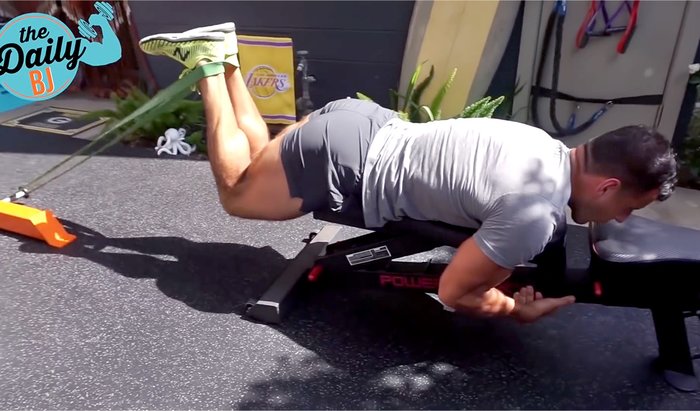
This is as pure a knee flexion exercise/lower hamstring movement as it gets. You can use any leg curl machine for this: seated, lying supine, or standing single-leg, but I train at home and I don't have a leg curl machine, so I modify with resistance band leg curls. And honestly, I think it's as good as a machine, and possibly better. Bands are great because they provide peak tension at peak contraction with less overall joint stress. They also work really well for faster muscle actions and high-rep sets.
One of my favorite ham-centric starters or finishers is to do 100 reps in as few sets as possible. Pick a resistance that is challenging for 20-30 reps in a single set, stopping before your rep quality goes down the toilet. Rest 10-20 seconds, and repeat until you hit the century mark.
2. Stability Ball Leg Curl
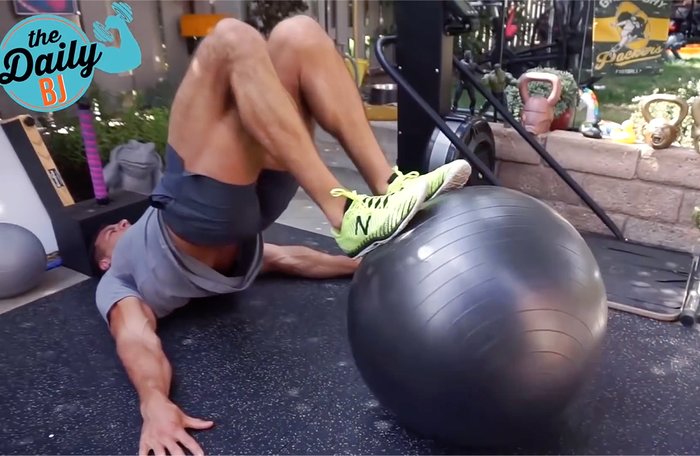
Stability ball or sliding/rolling leg curls kill two birds with one stone by training knee flexion dynamically while maintaining hip extension isometrically. If you had to just pick one move for hamstrings, this just might be it. The fact that there's little to no spinal stress means this move is much easier to recover from than deadlifts. So you can perform it more frequently, while boosting your core stability and hip mobility at the same time.
I like sets of 8-15 reps with an accentuated eccentric phase, taking 3-5 seconds on the way out. Once you master this drill, progress to the single-leg variation to strengthen imbalances between sides.
3. Band-Resisted Rolling Leg Curl
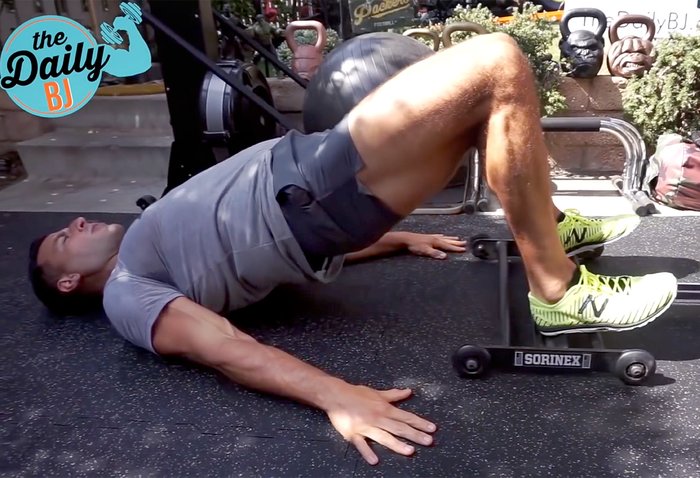
Many trainees discount the muscle-building potential of bodyweight moves for legs, as I discussed in my article "The One-Move Leg Workout from Hell." After all, how can you progressively overload it without doing endless reps? Well, here's one way to do so.
Adding band tension to your feet or ankles will dramatically increase the challenge to your knee flexors. I use the glute-ham roller from Sorinex that allows you to attach band or cable resistance. But you can modify this move by looping bands around your feet or using ankle cuffs. I dig sets of 6-8 reps with heavier bands, and sets of 10-12 reps or more with lighter bands.
You could also add band resistance by placing a band around your hips and pinning it to the floor with your hands or wrists. This will stress your high hamstrings slightly more.
4. Feet-Elevated Hip Thrust
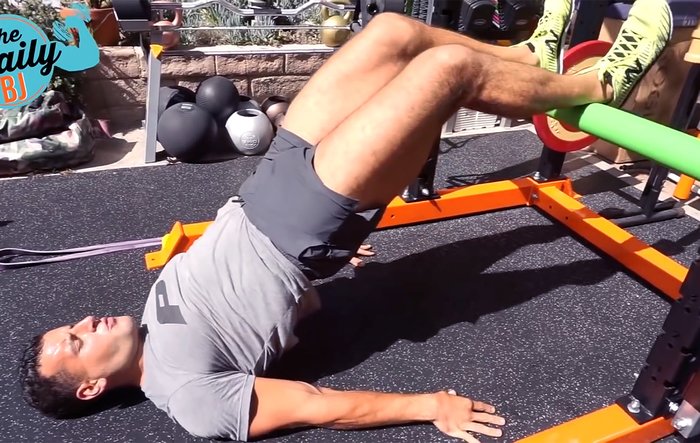
Hip thrusts have been shown in muscle activation research to be a better butt-building exercise than squats or deadlifts.[1,2] They also have a smaller learning curve and can be performed anytime, anywhere. Oh, and they're a phenomenal hamstring exercise, too.
You can do these on the floor or with your shoulders or feet elevated. The feet-elevated option is the winner when it comes to hamstring activation. The higher the elevation (as long as your head and upper back can comfortably rest on the floor), the more your hamstrings will hate you. Nothing beats the pump from a couple sets of max reps. Once you can easily do 20-plus reps on both legs, progress to the single-leg option. Still too easy? I doubt it. But you can always wrap a mini-band just above your knees to increase the resistance through your hips.
5. Single-Arm Bulgarian Hip Hinge
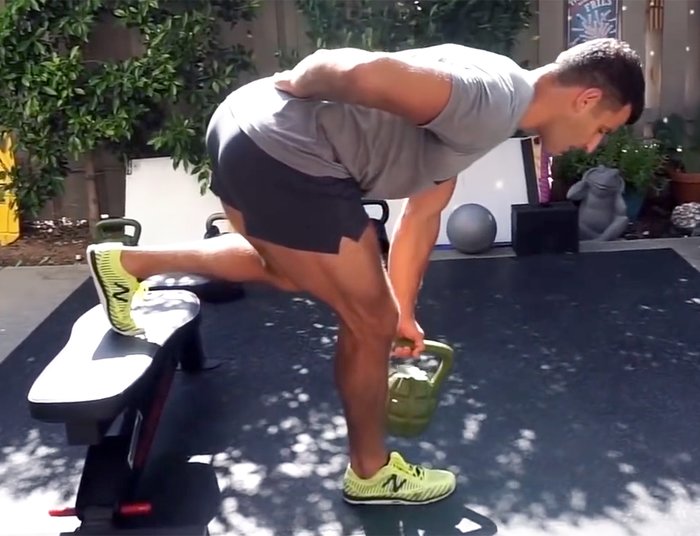
Consider this the hamstrings-oriented version of the Bulgarian split squat, where you keep the knee of your front leg soft and only move through your hips. This will sizzle and stretch your hamstrings and dramatically improve single-leg balance. The secret sauce to this move is the trail leg support, providing just enough stability for uninterrupted sets using challenging loads. Think of it like a kickstand on a bike.
Personally, I prefer to load this exercise one arm a time. It increases core and hip activation while making lighter loads go a longer way. Holding on the same arm as the lead leg will increase inner hip and thigh activation. Holding on the opposite arm will boost lateral hip activation. Keep the rear delt on your holding arm tensed and active for proper shoulder and spinal positioning.
One of my favorite protocols is to do 2-3-minute sets on one leg at a time, doing 60-90 seconds of work holding in one hand and then immediately switching hands for another 60-90 seconds. The time under tension is off the charts. Please note that your lower back muscles will burn too since they function as a stabilizer.
6. Kettlebell Swing
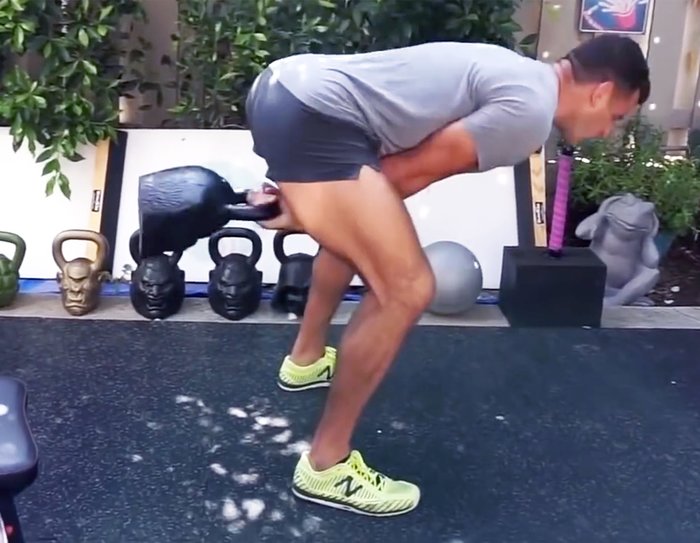
Your hamstrings are one of the most powerful muscles in your body, so you need to plug in some power training moves from time to time to tap into that explosive potential. The kettlebell swing, a ballistic hip-hinging pattern, is my preferred way of doing so. But be sure to master the basic hip-hinge pattern with a slow and controlled tempo before attempting this bad boy.
You can sit there and count reps while you swing, but I like to do these for time: sets of 10-20 seconds with heavy loads, sets of 30-60 seconds with medium loads, and sets of 90-120 seconds with lighter loads. You can also plug this move into HIIT or cardio intervals. One of my favorite glute-ham finishers is 30 seconds on, 30 seconds off for 5-10 rounds.
Wanna make your high hamstrings and glutes work harder with the same weight? Add band resistance around your hips facing away from the anchor point.
7. Glute-Ham Raise (GHR) and Russian Leg Curl
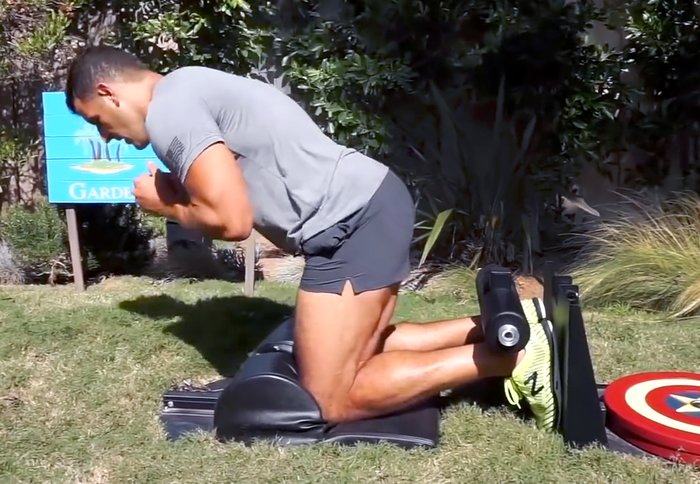
These moves are the epitome of "your body is your barbell." There's simply no better strength and mass builder for the hamstrings! They even work your upper calves as knee flexors. The only problem is these drills are nearly impossible for beginners or heavier trainees.
That said, they're still worth learning because they are also one of the best exercises to prevent hamstring tears. Start with the GHR (only moving through the hips) before progressing to the Russian leg curl (only moving through the knees). And use eccentric-only and band-assisted options to gradually build up to flawless full-range-of-motion execution.
There are two ways I recommend using these drills. One is with a slower tempo in the 6-8 rep range with a 3-5-second lowering and a 1-2-second pause at the bottom. These will cause more muscle damage and soreness, so just start with 1-2 sets in the beginning. The other is for higher reps of 10-15 or more at a faster tempo.
Finally, I recommend maintaining a slight hip-hinge while performing Russian leg curls. This is not cheating, though it may look that way. Rather, it will result in better spinal positioning and hamstring activation. Trust me on this!
8. Wide-Stance Landmine Sumo Hip Hinge
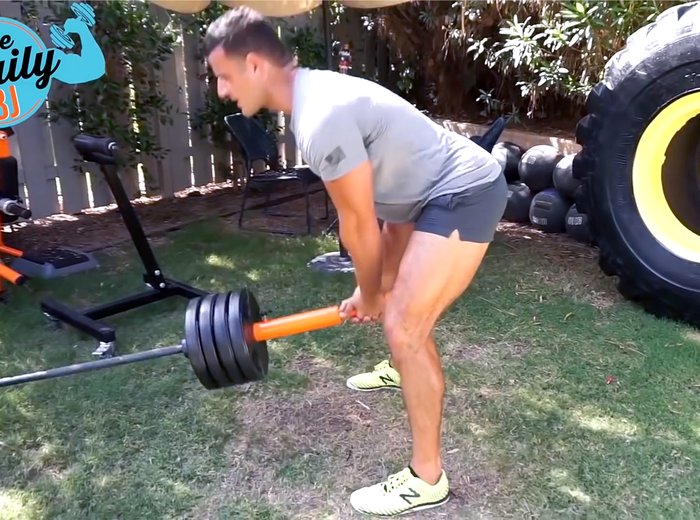
A close stance on hip hinges hits the outer hamstrings to a greater degree, whereas a wider sumo-style stance shifts the emphasis to the inner hamstrings. Both options are worth using, but I'm highlighting the sumo stance because it's the option least used by the average gym-goer.
I personally prefer using the landmine setup for hip hinging, where you place one end of a barbell into a landmine post or corner of a wall and use the other end to train with. It's really the ultimate at-home training option, and I use it both in my garage and backyard gym. It's also much easier to learn with less inherent spinal stress than the traditional barbell option.
Though it's not required, I also recommend using the war hammer attachment from Purmotion. Not only does it provide a more user-friendly gripping option, but it creates more space and separation from the bar and plates.
I recommend a few sets of 6-8 reps with a heavier load followed by a few back-off sets of 15-20 reps with a lighter load.
9. Single-Arm Landmine Hip Hinge
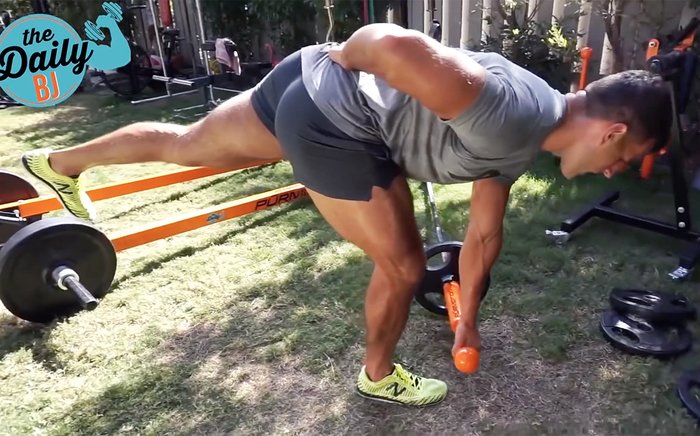
This is my favorite way to do single-leg hip hinges, just edging out Bulgarian hip hinges. You get the perfect blend of joint-friendly training angles and stability, so you don't spend too much time and energy worrying about your balance.
You can also perform it with two unique body orientations: facing the unit from the front or from the side. Please note that you can only grip the bar with the opposite hand when using the side-facing positioning.
I recommend using smaller 25-pound plates for loading, since you can squeeze out more range of motion, a critical aspect of stimulating growth in the hamstrings. You could also stand on a weight plate or low box using bigger plates to make light weight feel heavy.
That said, only go as low as you can while maintaining a neutral position (slight arch) in your lumbar spine (lower back). A slight rounding of the upper back is acceptable and can actually help create a posterior pelvic tilt, which increases gluteal activation at the top of the move.
10. Dual Landmine Hip Hinge (Parallel and Staggered)
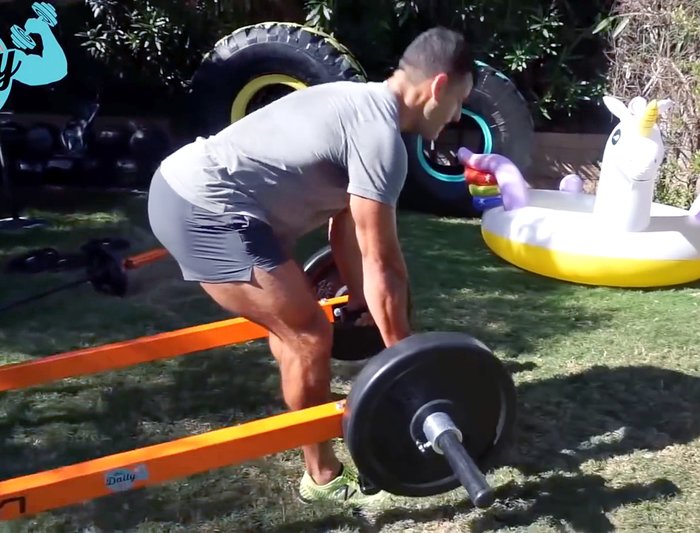
The tenth and final move uses two barbells set parallel to your body. You can jury-rig this at home like a double landmine, although I use another piece of machinery from Purmotion. No matter how you craft it, I dig this option because it's hard on the hamstrings and easier on the lower back.
Why do I like hip hinges over traditional deadlifting? Yes, you can use heavier loads with conventional or sumo deadlifting and get more likes and shares when posting on social media. But that's because you can bend your knees and use your quads for assistance.
If the goal is to target the hamstrings, you're better suited taking your quads out of the equation and isolating the hip-hinging pattern. After all, the quads are better worked with squatting and lunging variations. And again, when it comes to longevity, it's all about putting your ego to the side and proactively finding ways to make lighter loads go a longer way.
I love going heavy on these for 4-6 reps, while stretching out each rep with a 3-5-second eccentric phase to make sure I'm owning the movement instead of just grinding through it.
For the best of both worlds, follow your low rep sets by cutting the load in half and throwing in a couple of 15-30-rep sets with a faster tempo. This is where strength meets cardio and shredz meets gainz. The staggered-stance option is also another great away to make the same weight feel heavier while stressing one side more than the other.
Like to feel the good hurt in the comforts of home? Try Home Body: 8-Week At-Home Fitness Plan with Kym Nonstop. Each follow-along video workout is designed to hit the sweet spot of intensity and variety, with a minimum of equipment!
References
- Contreras, B., Vigotsky, A. D., Schoenfeld, B. J., Beardsley, C., & Cronin, J. (2015). A comparison of gluteus maximus, biceps femoris, and vastus lateralis electromyographic activity in the back squat and barbell hip thrust exercises. Journal of Applied Biomechanics, 31(6), 452-458.
- Zweifel, M. B., Vigotsky, A. D., Contreras, B., & Simiyu, W. W. N. (2017). Effects of 6-week squat, deadlift, or hip thrust training program on speed, power, agility, and strength in experienced lifters: A pilot study. Journal of Trainology, 6(1), 13-17.
